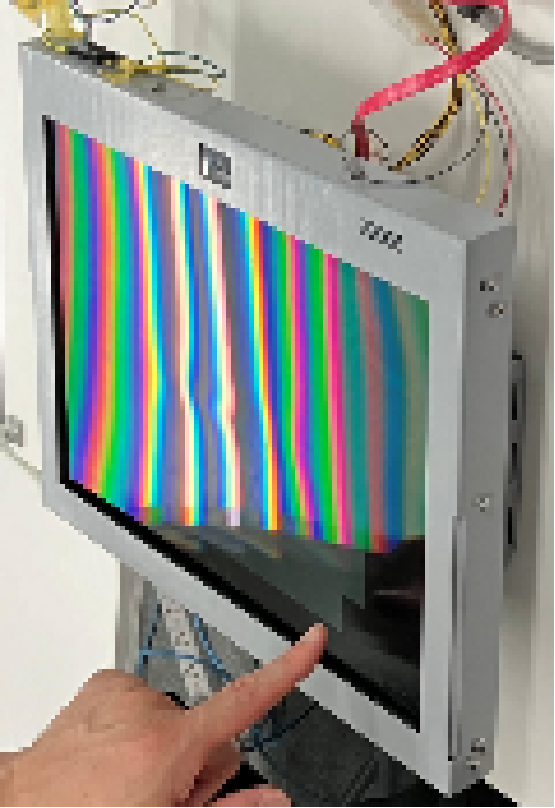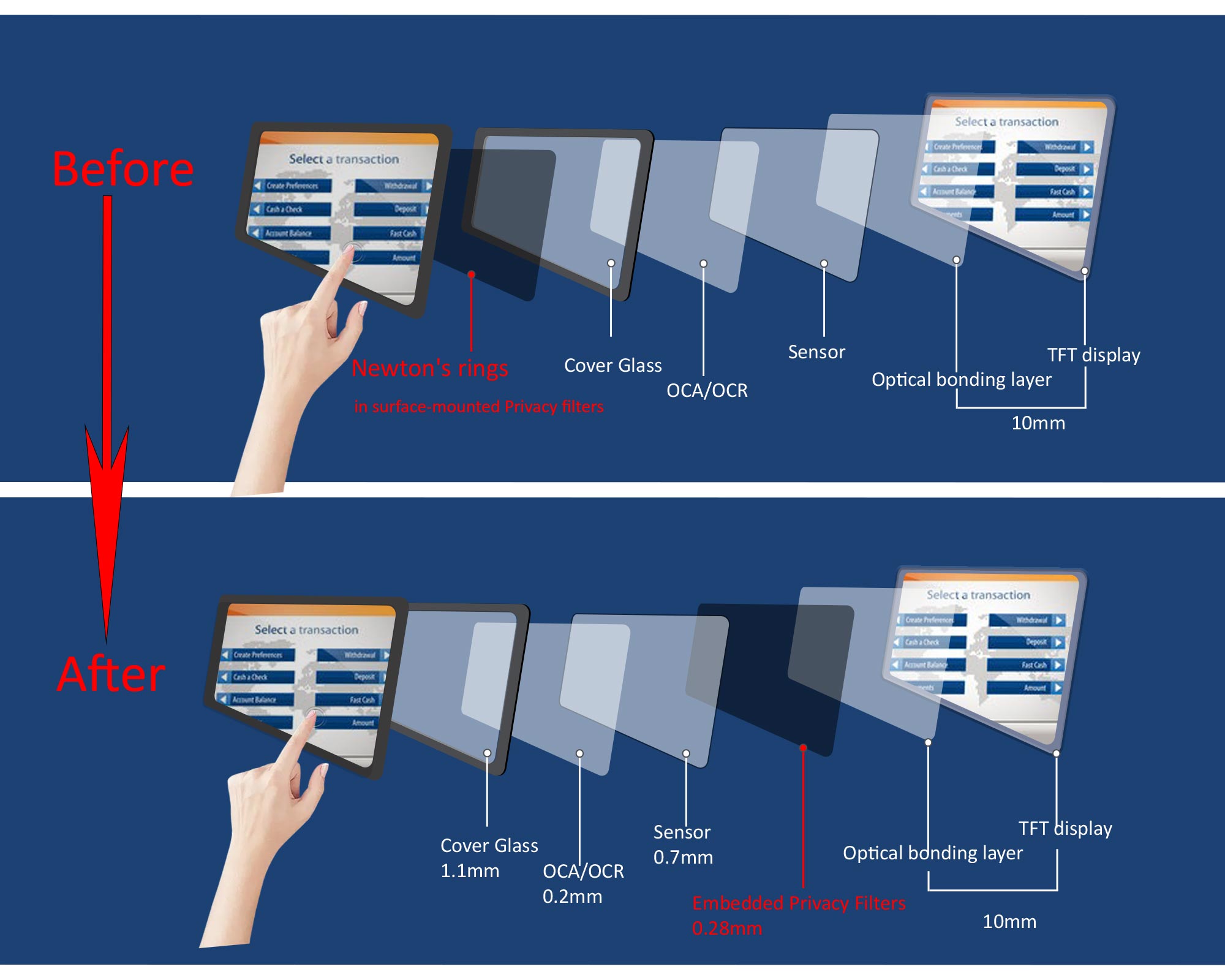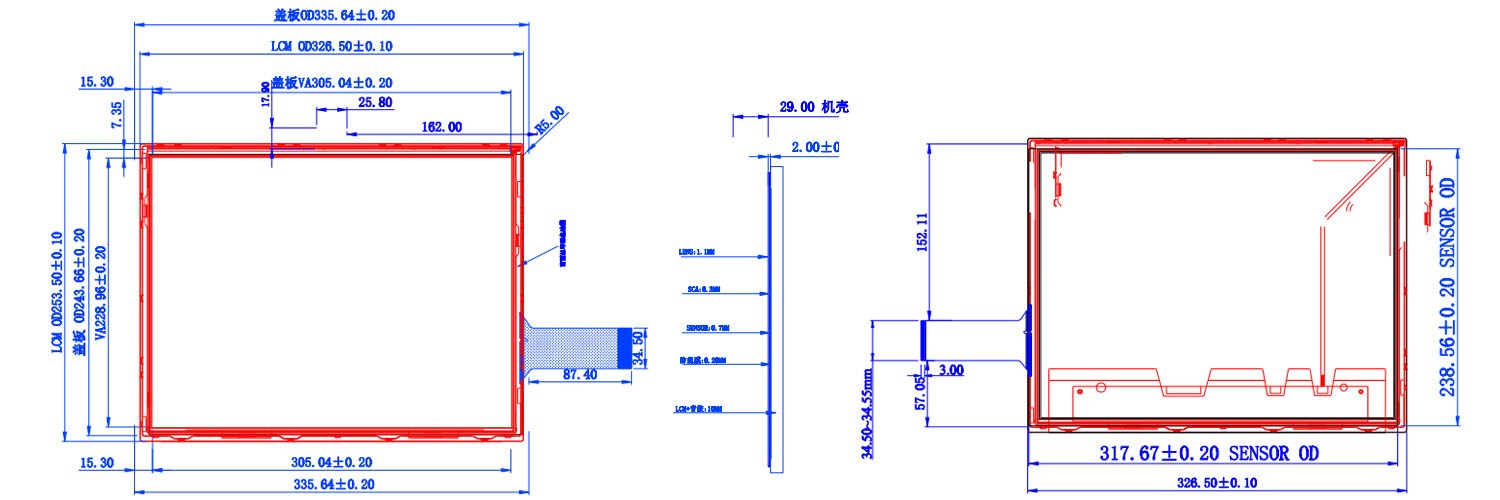Structural Innovation in Touch-Privacy Displays: Eliminating Newton's Rings via Embedded Filter Integration
Abstract
This study systematically addresses integration challenges in industrial touch-privacy displays, focusing on resolving Newton's rings (rainbow patterns) inherent in surface-mounted privacy filters. Through empirical analysis and structural innovation, we developed an embedded integration methodology where privacy filters are laminated within the touchscreen stack. This solution enabled a market-competitive display for ATM applications. Field validation confirmed:
Factory lab validation confirms:
Optical surface defects (Newton's rings) were eliminated within budget constraints,
while privacy performance was maintained without compromising optical clarity.
The resulting technology delivers mission-critical reliability for financial hardware, serving as the technical foundation for stability-sensitive ATM platforms.
一. Problem Analysis : Optical Defects
Traditional privacy filters offer significant advantages in enhancing user privacy by effectively restricting screen viewing angles and preventing visual eavesdropping of sensitive information from oblique perspectives. However, these filters present notable technical limitations impacting display quality and user experience during actual use.
The most prominent issue stems from microscopic air gaps between the privacy filters and touchscreen surface. Privacy screen typically employ multi-layer optical structures, and inadequate lamination creates an interstitial air layer. Refractive index differences at the air-glass-filters interfaces trigger multi-path light reflection and interference phenomena. Under specific viewing angles or lighting conditions, this optical interference manifests as visible iridescence (Newton's rings), which not only compromises visual clarity but also significantly reduces display contrast and color fidelity. The resulting image degradation – characterized by murky, hazy visuals – detrimentally impacts reading and viewing experiences.

Inadequate filters-to-screen lamination constitutes the primary cause of air gap formation. During user-applied installations, achieving completely dust-free and seamless adhesion proves challenging, often leaving residual bubbles or contaminants along edges or localized areas that exacerbate light interference. Even with proper initial application, frequent touch interactions and screen pressure during daily use induce micro-wrinkles or localized lifting due to uneven stress distribution. These physical deformations compromise both aesthetic integrity and optical performance, intensifying iridescence while potentially impairing touch sensitivity.
二. Solution Architecture
Enhanced durability and improved visual clarity

2.Material Upgrade: OCA Adhesive
Precision Lamination with Optical Clear Adhesive (OCA)
High-transparency OCA bonds the privacy filters to sensor layers within touch screen, engineered exclusively for display assemblies—distinct from conventional adhesives.
Core Advantages:
Small refractive indexng
Ultra-High Transmittance
Flawless Surface Integrity
三. Solution Verification
1. Selected privacy screen: Feature-engineered with factory-validated
• Abrasion/Scratch Resistance
• Anti-Glare Performance
• Precision Light Control (30° viewing cone confinement per VESA FPDM 303.01)
|
Items |
Inspection Standards |
Standard value |
|
Use layer thickness |
GB/T 33399 |
490±20μm |
|
Total Luminous Transmittance |
GB/T 2410 |
≥60% |
|
Haze |
GB/T 2410 |
25-28% |
|
Transmittance at ±30° |
/ |
≤ 15% |
|
Damp Heat Test |
65℃/90%RH*1000H |
No bubbles, cracks or other appearance defects |
|
Hot and cold shock cycle |
-40℃*1H,95℃*1H,300cycles |
No bubbles, cracks or other appearance defects |
|
High Temperature Test |
95℃*1000H |
No bubbles, cracks or other appearance defects |
|
Low Temperature Test |
-40℃*1000H |
No bubbles, cracks or other appearance defects |
2. These are the specifications of the Privacy touch screen processed in a Class 1000 dust-free workshop environment.

|
Specifications |
||
|
1 |
Product structure type |
Glass+Glass |
|
2 |
COVER LENS |
2.89MM Tempered glass |
|
3 |
COVER LENS Surface hardness |
>8H |
|
4 |
Transmittance without ink |
>=90% |
|
5 |
Operating temperature |
-10℃~70℃ |
|
6 |
Storage temperature |
-30℃~70℃ |
From the above parameters, we can know:
Military-Grade Durability: The 2.89mm glass thickness approaches military-grade standards for consumer electronics.
Exceptional Scratch & Impact Resistance: With a hardness rating of 8H—significantly exceeding the standard 7H—this glass combats malicious scratches and physical impacts, safeguarding devices in high-traffic public environments.
Premium Clarity & Privacy: Featuring 90% light transmittance (near the optical glass limit) and integrated anti-peep technology, it ensures sharp, clear visuals from the front while automatically obscuring side views to protect sensitive information like passwords.
Extreme Environment Reliability: An operating temperature range of -10°C to 70°C (-14°F to 158°F) ensures stable performance in most global extremes, meeting the 24/7 demands of outdoor ATMs. Privacy touch screen's Structural Optimization technology achieves the optimal balance between robust protection and superior display quality, fully complying with financial equipment safety standards.
四. Cost Advantage
About Core Component of the Touch Privacy Display: The LCD Panel
*We utilize the mainstream BOE model DV150X0M-N10.*
| 15 Inch LVDS 1024*768 different model | |||||||
| Brand | Model | Price | Brightness | Contrast | Active Area | LED Life Time | Work Temp |
| Innolux | G150XNE-L03 | $62 | 300 | 2000:1 | 304.128*228.096 | 70K | -20/70 |
| AUO | G150XTN06.2 | $95 | 300 | 700:1 | 304.128*228.096 | 50K | -30/85 |
| BOE | DV150X0M-N10 | $49 | 350 | 1000:1 | 304.128*228.096 | 50K | -20/70 |
| BOE | EV150X0M-N10 | $56 | 350 | 1000:1 | 304.128*228.096 | 50K | -20/70 |
| AUO | G150XTN03.5 | $60 | 350 | 800:1 | 304.128*228.096 | 50K | 0/65 |
| IVO | M150GWX3 R0 | $64 | 400 | 800:1 | 304.13*228.1 | 50K | -20/70 |
| AUO | G150XAN01.0 | $89 | 400 | 1000:1 | 304.128*228.096 | 50K | -20/70 |
| AUO | G150XTN06.4 | $108 | 400 | 800:1 | 304.128*228.096 | 50K | -30/85 |
| Tianma | TM150TDSG71 | $72 | 450 | 800:1 | 304.128*228.096 | 50K | -20/70 |
| AUO | G150XTN06.0 | $87 | 450 | 800:1 | 304.128*228.096 | 50K | -30/85 |
| AUO | G150XTN06.8 | $96 | 450 | 800:1 | 304.128*228.096 | 50K | -30/85 |
| AUO | G150XAN02.0 | $70 | 500 | 1000:1 | 304.128*228.096 | 50K | -30/85 |
| Innolux | G150XNE-L01 | $78 | 500 | 2500:1 | 304.128*228.096 | 70K | -30/80 |
| AUO | G150XAN01.2 | $87 | 500 | 1000:1 | 304.128*228.096 | 50K | -20/70 |
| BOE | DV150X0M-N16 | $70 | 600 | 1000:1 | 304.128*228.096 | 50K | -20/70 |
| AUO | G150XAN02.1 | $112 | 800 | 1000:1 | 304.128*228.096 | 50K | -20/75 |
| AUO | G150XTN06.A | $206 | 1800 | 800:1 | 304.128*228.096 | 50K | -30/70 |
| AUO | G150XAN02.2 | $242 | 1800 | 1000:1 | 304.128*228.096 | 50K | -30/70 |
Selection Rationale:
Among comparable options, the DV150X0M-N10 offers the most cost-effective solution while delivering solid mid-range specifications.